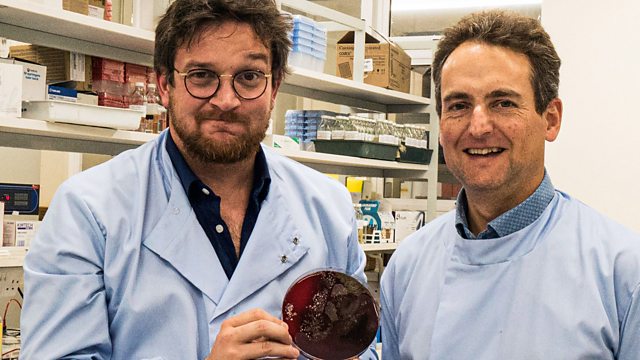Secrets of Skin episode 3 – Protection: How does a giraffe stay cool? What are different porcupine quills teaching us about medicine? What makes some people more likely to be bitten by mosquitoes than others? All the answers and more lie in the secrets of how skin protects us from a hostile world. When it comes to protecting our delicate insides, skin is like an external suit of armour. Animals have adapted ways of protecting themselves from everything a hostile planet has to throw at them.
Hippos produce their own sunscreen to protect themselves against the dangers of UV rays from the sun. Only recently discovered by science, is the truth behind a giraffe’s spots, a network of blood vessels that they use to cool themselves down in the blazing heat of the African savannah.
Professor Ben Garrod discovers how. He tests the limitations of human skin by plunging himself into a deep freezer to demonstrate how human skin just isn’t well insulated enough to cope with extreme cold. He discovers how human skin is an entire ecosystem for bugs and bacteria as he comes face to face with what is growing on his skin. And he gets bitten by mosquitoes and stable flies as he learns that disease-carrying insects have evolved to pierce everything from human skin to horse hide.
Featuring groundbreaking new science, experiments and leading scientists from a variety of disciplines, the series unravels the natural history of the body’s largest organ.
Secrets of Skin episode 3 – Protection
Skin is the layer of usually soft, flexible outer tissue covering the body of a vertebrate animal, with three main functions: protection, regulation, and sensation. Other animal coverings, such as the arthropod exoskeleton, have different developmental origin, structure and chemical composition. The adjective cutaneous means “of the skin” (from Latin cutis ‘skin’). In mammals, the skin is an organ of the integumentary system made up of multiple layers of ectodermal tissue and guards the underlying muscles, bones, ligaments, and internal organs.
Skin of a different nature exists in amphibians, reptiles, and birds. Skin (including cutaneous and subcutaneous tissues) plays crucial roles in formation, structure, and function of extraskeletal apparatus such as horns of bovids (e.g., cattle) and rhinos, cervids’ antlers, giraffids’ ossicones, armadillos’ osteoderm, and os penis/os clitoris.
All mammals have some hair on their skin, even marine mammals like whales, dolphins, and porpoises that appear to be hairless. The skin interfaces with the environment and is the first line of defense from external factors. For example, the skin plays a key role in protecting the body against pathogens and excessive water loss. Its other functions are insulation, temperature regulation, sensation, and the production of vitamin D folates. Severely damaged skin may heal by forming scar tissue. This is sometimes discoloured and depigmented. The thickness of skin also varies from location to location on an organism. In humans, for example, the skin located under the eyes and around the eyelids is the thinnest skin on the body at 0.5 mm thick and is one of the first areas to show signs of aging such as “crows feet” and wrinkles. The skin on the palms and the soles of the feet is the thickest skin on the body as 4 mm thick. The speed and quality of wound healing in skin is promoted by the reception of estrogen.




